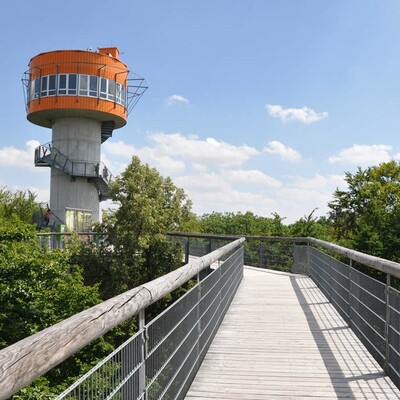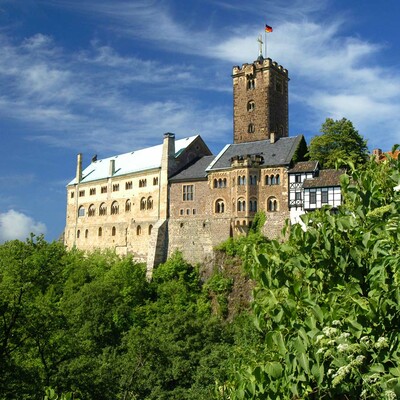
Cultural holiday in Thuringia
Thuringia offers culture lovers numerous reasons to spend their holidays here. The Free State has many important sites from the fields of art, culture and science.
In addition, you can expect an almost endless range of cultural meeting places, castles, palaces and museums as well as an incredible amount of entertainment programmes and concerts. Great names such as Johann Wolfgang von Goethe, Friedrich Schiller and Franz Liszt are also inextricably linked with Thuringia. These and other important personalities have left their traces in the green heart of Germany, which you can still follow today.
Between Weimar Classicism
& Luthers Reformation
Thuringia's cities and sights are silent witnesses to all-German culture. The state capital Erfurt with its old university, the classical city of Weimar as the birthplace of a new literary era, or the Wartburg city of Eisenach, which provided shelter for Martin Luther during his translation of the Bible. Culture in Thuringia's cities has a long tradition. In the 18th and 19th centuries, the Free State experienced its cultural heyday and developed into the centre of German culture.
Not only the great German poets around Schiller, Herder and Goethe met in Thuringia. In 1808, the great imperial congress between Russia and the ruler of France, Napoleon I, took place in Erfurt. At Wartburg Castle, the Burschenschaften came together as a national, liberal movement.
In the heart of Germany, the first kindergarten was founded by Friedrich Froebel in Rudolstadt. The first Duden was published in Schleiz. And at the beginning of the 20th century, the foundation stone for the modern avant-garde was laid in Weimar at the State Bauhaus School of Art, Culture in Thuringia looks back on an impressive history.
Thuringia's culture in every corner
Such history can only provide the ideal setting for a holiday of a special kind. In the Free State of Thuringia, culture is within reach, even today. Everywhere in the green heart of Germany you will find sights that tell their very own stories. Be it the music town of Sondershausen with its beautiful residential palace in the north, the thousand-year-old skat town of Altenburg with its historic old town in the east, the wonderful Meiningen including its famous theatre in the south or Mühlhausen in the west of Thuringia with its numerous churches in the town centre. You probably won't manage to experience all the culture in Thuringia, but no matter which region you choose, you are making the right decision.
Modernity and tradition go hand in hand
Experiencing culture in Thuringia is not just about marvelling at history. The green heart of Germany also moves with the times and has established its own modern culture. Why not experience Thuringia's traditions and hospitality, enjoy its world-famous cuisine and go on the run with the free state's inhabitants. Get an insight into modern intersections of traditional customs and student culture in Thuringia.
The Classical City of Weimar in Thuringia
Weimar is probably the best-known cultural city in Thuringia. From the Oberhof holiday region, you can reach the city of classics in less than an hour. A day trip is worthwhile in any case. Visit the place where the poet princes Goethe and Schiller worked and let yourself be transported back to their time through the wonderful old town of Weimar. In the poets' residences you can gain an insight into their lives at the time. The buildings have been part of the "Classical Weimar" ensemble since 1998 and are UNESCO World Heritage Sites.
If you prefer something more sculptural, you can also see the two poets on the theatre square. Here they are immortalised in the bronze double statue of the Goethe-Schiller Monument. Next to the Kyffhäuser Monument, this is the most famous monument in Thuringia and is located directly in front of the German National Theatre. The latter can offer all types of theatre, including drama, musical theatre and dance theatre, which is a rarity among Thuringian theatres today.
Thuringia's state capital Erfurt
Erfurt, the capital of Thuringia, lies on the southern edge of the Thuringian Basin and also has numerous sights in store for its visitors. So it, too, offers a reason for a holiday in Thuringia. From Oberhof, you can reach Erfurt in just 50 minutes by car.
The University of Erfurt is the third university to be founded on German soil. The famous reformer Martin Luther once studied here. His work in the city is still commemorated today by the Luther Monument in front of the Kaufmannskirche on the Anger. Numerous sacred buildings still bear witness to the city's ecclesiastical history. The most famous example is the ensemble of the cathedral and the Severi Church on Domplatz. This is the city's landmark. The cathedral itself houses the largest free-swinging medieval bell in the world, the Gloriosa. But it is not only the Christian faith that is intertwined with the city's history. There are also numerous testimonies to the Jewish faith. For example, the oldest preserved synagogue in Europe is located in Erfurt. During excavations in the centre of the old town, a Jewish treasure was found in 1998. It is one of the most important testimonies to Jewish culture in medieval Europe.
The medieval old town centre, which covers an area of around three square kilometres, will take you back to bygone eras. Here you will find numerous well-preserved half-timbered houses and town houses. The city's most famous secular building, the Krämerbrücke, is also located in the old town. It is located directly behind Erfurt's fish market and spans the river Gera over a length of 120 metres. This makes it the longest completely built and inhabited bridge in Europe. It is a must-see for tourists and another reason for a holiday in Thuringia.
The residential town of Gotha in Thuringia
Only 40 km from the holiday resort of Oberhof lies the former capital and residence town of the Duchy of Saxe-Gotha. Once the connecting road of the princes between Gotha and Coburg was one of the reasons for Oberhof's touristic development. Even from a distance you can see the town's landmark, the baroque Friedenstein Castle. This dominates the silhouette of the town due to its impressive size and elevated position. It is the largest early baroque feudal building in Germany.
Friedenstein Castle itself offers several interesting sights. For example, it houses the world's oldest baroque theatre with functioning stage machinery from the 17th century. It also has the oldest English garden on the European continent. The Gotha Orangery is also part of the palace garden. The late Baroque gardens were built in the 18th century by order of Duke Friedrich III of Saxe-Gotha-Altenburg. It is one of the largest such complexes in the German-speaking world. The west tower of Friedenstein Palace now houses the Gotha Museum of Nature. This is the largest natural history museum in Thuringia. Among other things, the oldest preserved specimen of an elephant cow is exhibited here. A new permanent exhibition, "Animals in the Tower", was opened at the Gotha Museum of Nature.
Gotha is also the birthplace of the German insurance industry, which was founded in 1820. You can gain an insight into its long history at the Gotha House of Insurance History. This is the only museum of insurance history in Germany.
In addition to the beautiful buildings and the lively history of the city, Gotha is a great place for a leisurely shopping trip through the lovingly renovated old town. Less hustle and bustle than in the big cities, but with a nevertheless extensive range of products.
The theatre town of Meiningen in Thuringia
The theatre town of Meiningen is located directly between the Thuringian Forest and the Rhön Mountains. It is a popular destination for all lovers of culture and theatre and lies only 35 km southwest of Oberhof. The former residence town of the Duchy of Saxe-Meiningen was developed by the dukes into the art and cultural centre of southern Thuringia. It maintained its reputation as the most important town in southern Thuringia into the 20th century. Meiningen became particularly famous for Duke George II's theatre reforms. These established modern director's theatre in the theatre and had a model effect for Germany and Europe. For this reason, the Meiningen Theatre is now one of the town's main attractions. After the building was destroyed by fire in 1908, it was rebuilt in 1909 in neoclassical style. Today it is a regular venue for well-known operas, musicals and plays.
The former residence of the dukes, the baroque Elisabethenburg Palace, also invites visitors. Special sights here include the marble hall, the wedding room decorated with gold, the Bibrasbau, the "Concert Hall Johannes Brahms" and the baroque tower café. Meiningen's town centre is characterised by many classicist buildings and extensive parks. The historic old town also has well-preserved half-timbered buildings and town houses.








